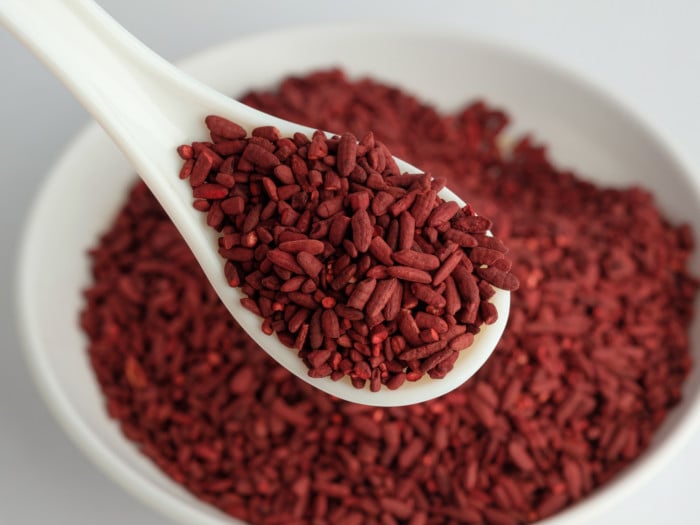Traditional Chinese medicine has made the use of red yeast rice for centuries, but its full impact on health and wellness is still being uncovered.
What is Red Yeast Rice?
Red yeast rice is a particular strain of fungus that grows on rice and can be processed, dried, and utilized as a health supplement. Chinese medicine has long trusted red yeast rice as a natural medication for the treatment of high blood pressure. Modern research has shown that this traditional medicine contains active ingredients that are nearly identical to modern high blood pressure medicines, specifically a compound called monacolin K. Whether you are taking this substance as an oral supplement or eating it in various dietary forms (primarily in Asia), it can have a number of benefits when consumed responsibly. [1]

Red yeast rice is a traditional Chinese culinary and medicinal product. Photo Credit: Shutterstock
Dosage
While the therapeutic effects of red yeast rice have been verified and validated on both sides of the globe, the amount of this supplement that you take is important, given the potential side effects that can result, as explained further in the section below. Supplements are the primary means of consumption, although this ingredient can also be found as a food coloring in cheese, fish and alcoholic beverages. [2]
There have been extensive studies on the proper dosage of red yeast rice in order to establish the ideal therapeutic value, but there doesn’t seem to be a definitive daily recommendation.
Generally, researchers suggest a range of 1,200-2,400 milligrams per day, in tablet or capsule form (2-3 per day). Depending on how these supplements are prepared, this could represent anywhere from 2-20 milligrams of monacolin K, the key ingredient credited with most of the cardiovascular benefits in a variety of formal studies. [3]
Given the importance of red yeast rice in traditional Chinese medicine, there are many different opinions, recipes, and recommendations for consumption. There is no definitive way of knowing how much of the active ingredient is present in many varieties, so always purchase these supplements from reputable distributors or professionals. Additionally, depending on where you are in the world, red yeast rice supplements may be classified either as a normal food ingredient or as a drug, due to its chemical makeup. Be sure to speak with a doctor or trained physician about an appropriate dose before making this a regular part of your health regimen.
Side Effects
As mentioned above, there are some potentially unpleasant side effects that can occur when you take red yeast rice, even if you don’t consume an excessive amount.
Blood Pressure: The desire to lower “bad” cholesterol is widespread, particularly for those who suffer from high blood pressure, high cholesterol or are at an elevated risk for strokes or heart attacks. The monacolin K found in some strains of red yeast rice can help suppress high blood pressure, like many other therapeutic statins, as shown in this study published in Complementary Therapies in Medicine. However, when your blood pressure drops too far, it can also be dangerous, or even fatal! It is generally not recommended to use red yeast rice for longer than 12 weeks; in other words, pharmaceutical statins can be used on a permanent basis, but not when similar active ingredients come from this natural and somewhat unregulated source. [4]
Liver Health: Due to the effects that red yeast rice and its active ingredients can have on the liver, namely reducing its function, those with liver disease or those at a high risk of the disease should avoid this natural remedy. If you regularly consume more than two alcoholic beverages per day, you should also use this supplement with caution. Similarly, anyone with kidney disease or thyroid issues should not use red yeast rice, as it could exacerbate those conditions. [5]
Pregnancy: Pregnant women should not use this supplement, nor should those people who are taking blood thinners or medication intended to control blood pressure. While these medications can work in conjunction with the monacolin, which inhibits a certain enzyme needed to make cholesterol, it can also speed up the potential damage being done to the liver. [6]
Other side effects of using this supplement include:
- Headaches
- Dizziness
- Gas
- Bloating
- Cramping
- Heartburn
Muscle aches and weakness are possible, but less common, and may indicate a more serious negative reaction in the body. As with any traditional or alternative treatment, be sure to speak with your doctor first in order to avoid any dangerous drug interactions. [7]
